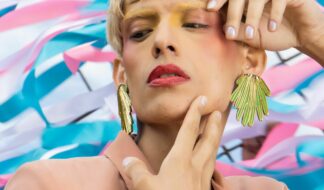By Jim Provenzano
Speed Racer: Olympic Skeleton star Courtney Yamada
The Winter Olympics in Torino, Italy, may be over, but for many athletes, almost making it that far serves as an inspiration to strive even harder. Courtney Yamada is one such athlete.
Selected as an alternate on the U.S. Olympic skeleton team, Yamada, 25, and teammate Noelle Pikus-Pace narrowly missed this year's Olympic dream when they did not rank among the top three in World Cup points. Teammate Katie Uhlaender was selected for the only position after the final World Cup competition in Altenberg, Germany, in late January.
But Yamada has already made sports history with a string of accomplishments, as a multiple medalist, the 2005 America's Cup Champion, and the only out lesbian in the relatively obscure sport.
Skeleton is a form of bobsled competition, using smaller sleds. Unlike luge, skeleton is always a single-athlete event for men and women. Competitors race down curving, icy tracks at speeds of up to 80 miles per hour. Most tracks have about 20 turns and are almost a mile long.
Born and raised in Idaho, Yamada attended the University of Alaska for two years on a ski-racing scholarship, which led to her being asked to join the U.S. ski-racing team.
Along the way, Yamada grew more open about being a lesbian. But when word got out in 2000 that she was dating another female athlete, Yamada says, "The ski racing world wasn't really open to that."
Yet Yamada persevered, gaining support from other athletes and friends. "I just got to the point where I didn't care anymore," she says. "It was comforting to know that people didn't care."
As for other LGBT athletes, Yamada knows she's not alone in the world of winter sports. "There are more than you think," she says. "They're out. Everybody knows they are, but they don't give interviews."
After building a nearly lifelong career in ski racing, Yamada took some time off, which became a hiatus of two years. When a friend in Park City, Utah, invited Yamada to try skeleton racing, she took to it quickly, and has been training since 2002.
Last year, Yamada was the top American finisher at the German leg of the World Cup, finishing 11th. Competitors are judged on the total of two runs, each barely over a minute long. Yamada finished at a combined time of 2:02.75. In January 2005, she also set a world record at Lake Placid's America's Cup, finishing one run at 56.53.
Having just returned from her first World Cup tour, where finalists in the Olympic team were judged in Lake Placid, Calgary, and Germany, Yamada was happy to have finished fifth in the world.
Along with the thrill of the sport comes the danger. In January 2004, at the Lake Placid course, Yamada had one bad accident.
"I got the green light to go, but there were two men standing in the track," says Yamada. "I smashed into them and shattered my collarbone." Yamada had to have steel plates screwed into her shoulder. It took almost a year for a full recovery.
With every skeleton track shaped differently, being a quick learner is essential. "We train on an Olympic track for a week, then for three or four days we compete," Yamada says. "In most places there's only one track per country." Even those track facilities are limited by whom competition officials allow to use them. In Torino, competitors are only allowed one practice run.
So, how does an athlete train in a sport hampered by such exclusivity? "As long as there's ice, we go to Park City and Lake Placid from October through February," Yamada says. "Once the ice is gone, all of our training goes to physical training – sprinting, lifting weights, and working on our push (the burst of movement when competitors jump on their sleds). We focus on the biomechanics, anything to get an edge."
"We learn a track's course, we memorize it, we do mind turns (mental imagery). You want to steer through the pressures. It's a lot of finesse, and at the same time, you're going 80 mph, and you have to react quickly."
At a height of 5'1," does Yamada's smaller size help? "For skeleton, there's no ideal height and weight," she says. "Some people say smallness is aerodynamic, but we're in a gravity sport." An athlete's total weight with a sled can't exceed a certain requirement. Yamada rides on a maximum-weight sled.
Yamada lives where her training takes her, from Lake Placid to Boise, Idaho, to spring and summer training in Chula Vista, Calif. "Putting so much time into your training, it's very difficult to get sponsors, because most people don't know what skeleton is," she says. "But every year, it becomes a little more known. We're getting more coverage."
Yamada says she does get some appreciation from fans. "People are kind of in awe of it," she says. "We're like stars in Europe, but in the U.S., gold medalists aren't even recognized. It's never gonna be huge, but we do it because we love it."
Televised competition doesn't compare to the thrill of witnessing the event, but as Yamada admits, "It's not spectator-friendly. The public can't go out and see it easily."
Watching this year's Olympics on television from across the world, instead of being in Torino, wasn't easy for Yamada. "To have come this close to the Games makes me want to commit fulltime for Vancouver in 2010," where the next Winter Olympics will be held. "It's a little bit tough to watch. It's exciting, it bums me out a bit, but it fuels the fire."









